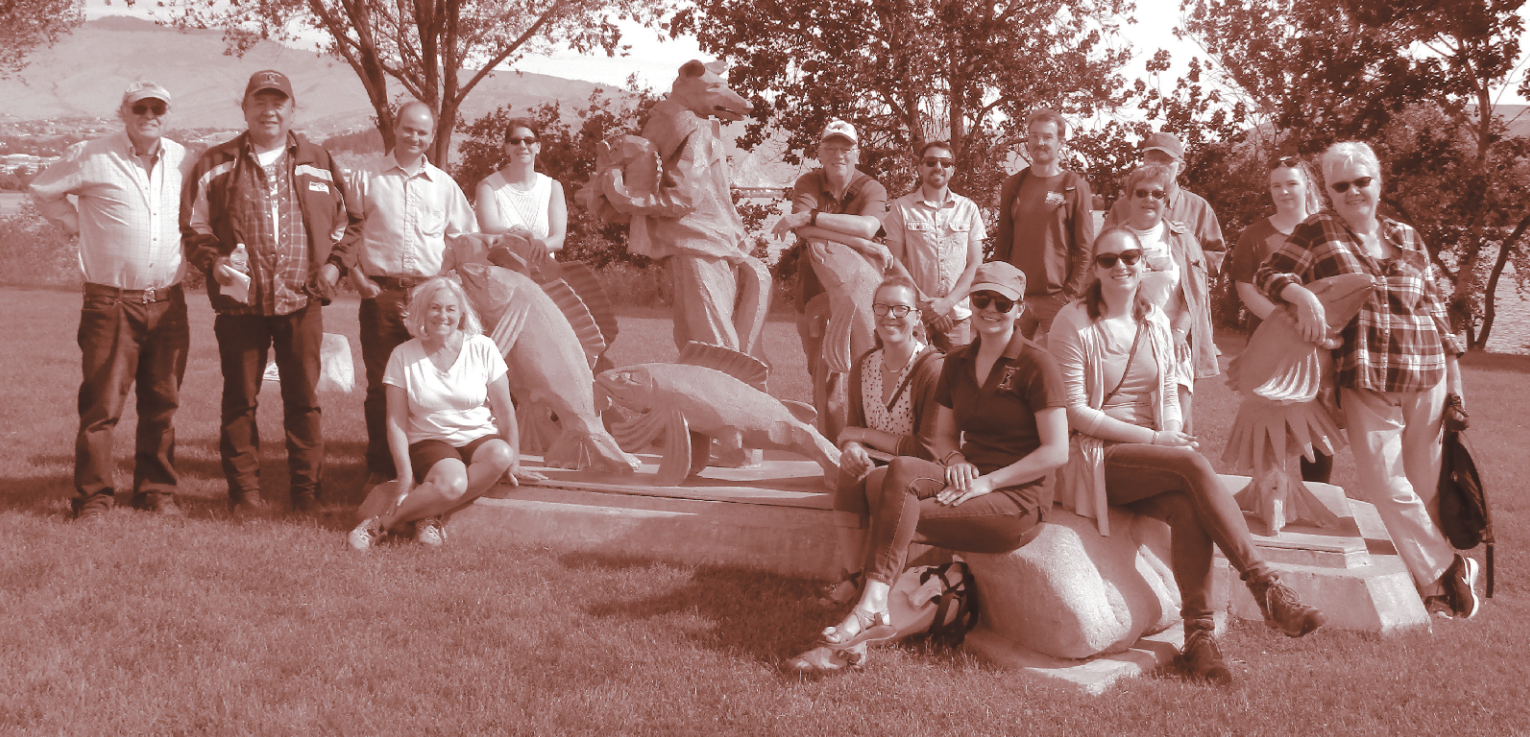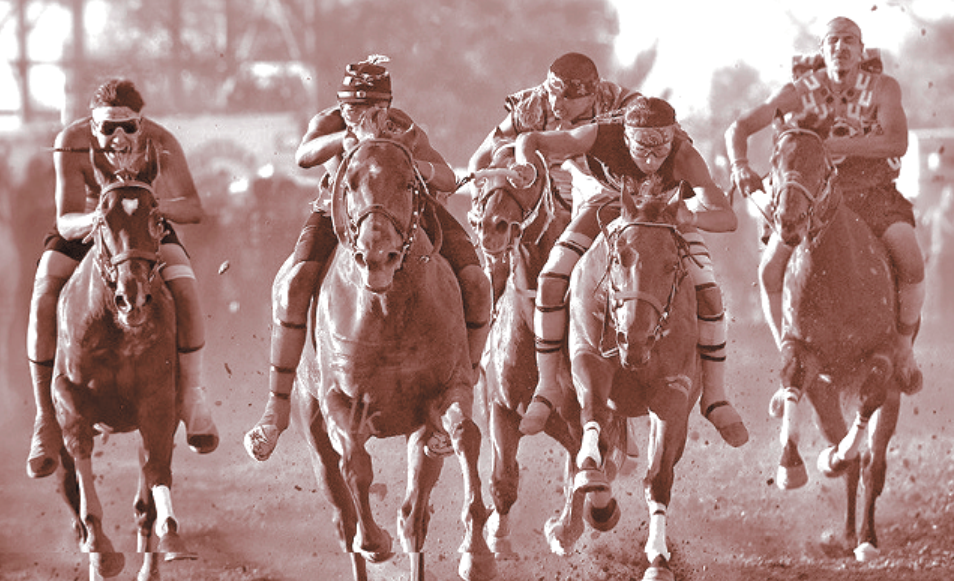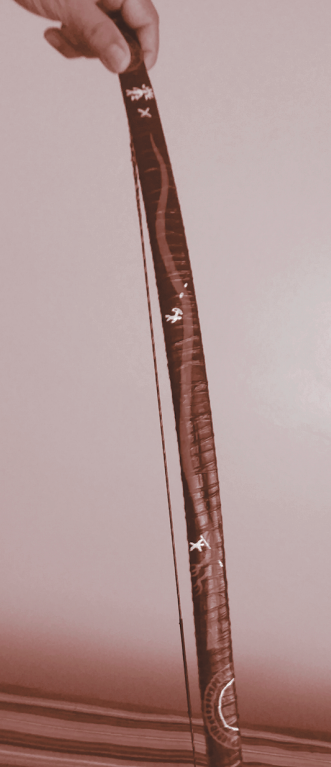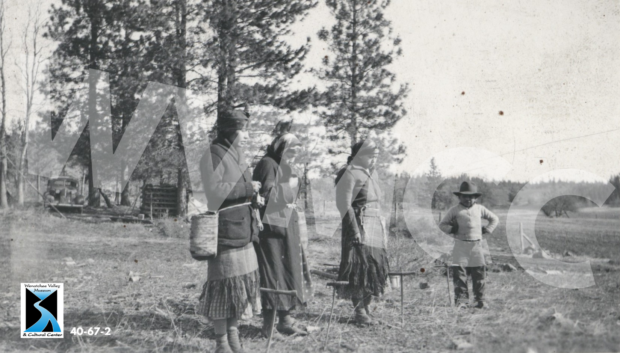Wenatchee-Columbia Confluence Has Long History – 07/06/2024
Photo source: Wenatchee Valley Museum #40-67-2. Native American women prepare for a first foods or first roots ceremony near Goldendale, Washington. Note the T-shaped digging sticks by their knees.
Written by Chris Rader
For thousands of years, a permanent village sat on the banks of the Columbia River just above the mouth of the Wenatchee River. Its Salish-speaking occupants called themselves the P’squosa, though they (and their tributary river) came to be known as the Wenatchi by the Sahaptan-speaking tribes to the south.

Source: William D. Layman Collection. This 1930 image by pioneer aerial photographer Bill Brubaker shows the Wenatchee River (top) flowing into the Columbia, before the Rock Island Dam raised the river level. The sandy area at the confluence was braided with streams during high water and resembled an otter’s paw.
“We think this site was continuously occupied for about six thousand years, before the time of the Egyptian pyramids,” Randy Lewis recently told staff members from the Wenatchee Valley Museum and Cultural Center. Lewis, or K’ayaxan, is descended from the Wenatchi-P’squosa and moved back to the area in 2018 (His story is on page 8 of this issue).
Lewis pointed to fire-broken rock, “hammer stones” that had been formed by knapping, flakes chipped from rock and bone during tool making, and other forms of “lithic scatter” revealing cultural modification of natural materials. “Rocks tell a story,” he pointed out. His eagle eye has spotted hearthstones, mortars, pestles, arrowheads, fossilized bone and petrified wood that evoke a civilization that passed from our region more than a century ago with the coming of European-descended settlers.
The topography of the area, now the 197-acre Confluence State Park, has changed over the years – especially with the construction of Rock Island Dam, which raised the level of the Columbia River in 1933. Lewis said the confluence/estuary was shaped like a hand with its fingers extended, or an otter’s paw with beaches or sand bars as webbing. Families had priority rights to put up dwellings at certain beaches there, but all shared the land.
The Wenatchi-P’squosa were a semi-nomadic people who moved around the Wenatchee watershed, hunting and gathering food in season. They had several “permanent” villages with pit and mat houses: at Cashmere, Monitor, the Wenatchee-Columbia confl uence, Swakane and Squilchuck, as well as temporary dwelling sites at Leavenworth and elsewhere (1).
Lewis said the harvest cycle began formally, each spring, with a “first foods” ceremony and dinner at the confluence that honored the Creator for his bounty. Large numbers would gather: Okanogans, Methows, Chelans, Entiats, Columbia/Sinkiuse and other Salish-speaking people from as far away as Idaho and Puget Sound.
“There were many dialects going on, but a common understanding,” he said. “People would come from upstream and downstream in canoes. Some would come over Snoqualmie Pass and meet up with relatives.”
During these early spring gatherings, and at other get-togethers at the confluence throughout the year, treaties or agreements were forged among bands; goods were traded; intermarriages were arranged and performed; and horse racing and gambling games provided entertainment. At “first foods,” people would dig swamp lily (sowrii) roots to be baked in a large, common underground “oven.” A pit was dug, lined with skunk cabbage leaves, loaded with roots, then covered lightly with leaves and sand. A fire was built on the sand and stoked until the coals were deemed ready. After the coals had cooled and been removed, the roots were dug up.

Photo by Chris Rader. City, PUD and museum staff and volunteers pose by the sculpture “Coyote Leading the Salmon” in Walla Walla Park in June 2019. From left: Bill Layman, Randy Lewis, Steve King, Chris Rader (seated), Keni Sturgeon, Bruce McCammon, Kasey Koski, Matt Shales, Melanie Wachholder, David Morgan, Kristin Lodge, Carol Hofmann, Jim Hoffman, Anna Spencer, Susan Evans.
“They would be of a cheesy or tofu-type consistency,” Lewis said. “They would be cut and divided among all present. After eating, this was the signal that everybody could spread out and dig roots.”
Roots were a staple of the Wenatchi-P’squosa diet, the first food to be harvested each spring. Lewis said his people had a saying: “When the snow melts, the dinner table is set.” They were well practiced at recognizing the early green shoots of each plant. Bitterroot (Lewisia rediviva, or spitlem to the indigenous people), arrowleaf balsam “sunflower” roots, wild carrots, wild onions, biscuit root and chocolate tips (lomatium), and Indian potato (wapato) were nutritious and filling.
Once the “first foods” or “release dinner” had been held at the confluence, the people spread to favorite digging grounds. Blue or meadow camas, itxwa, was a favorite – harvested on Badger Mountain in April and May, and in the Leavenworth and Blewett Pass areas in early June. The roots were peeled and baked underground to release the sugars. Those baked roots that weren’t eaten right away were dried for later rehydration and consumption. Peeled camas roots were also combined with pounded huckleberries and bear fat to make pemmican, a food that kept well and nourished people through the cold winter.
The Salish tribes did not keep written records but handed down verbal memories of their past through many generations. This included practical instructions as to uses of plants, animals and minerals; inspirational and humorous accounts of individuals and families; and stories of place. All Wenatchi-P’squosa children looked at Two Bears (Saddle Rock) and learned how two jealous wives, Black Bear and Grizzly, were turned to stone for their ceaseless bickering.
The story of the frightening water monster Spexman is evidenced in rock formations on the Columbia from Rock Island (Spexman’s head) past the Owl Sisters and the monster’s horns to above Entiat (his trail of blood), and at the Peshastin Pinnacles (the fish people) and up Stemilt Creek (Spexman’s spine). The story begins at the Wenatchee-Columbia confluence, birthplace of hero twins Red Star and Blue Star who ultimately brought Spexman down. Randy Lewis and Bill Layman recount this story in their illustrated paperback book Red Star and Blue Star Defeat Spexman (2018), available in the Wenatchee Valley Museum’s gift shop.
Caucasian explorers record early impressions
The native presence at the Wenatchee-Columbia confluence was noted by several exploration parties in the 19th century. Canadian fur trader and map maker David Thompson, the first Caucasian to navigate the entire 1,243-mile Columbia River, paddled past the mouth of the Wenatchee on July 7, 1811. His journal noted that the party had camped below the Entiat Rapids
the night before, after killing two rattlesnakes for food.
In the morning they viewed the high, rocky foothills with the snow-covered Cascades in the distance and spotted a few Wenatchi-P’squosa men on horseback. The explorers did not stop, however. It is likely that the rest of the band was upriver at their Wenatshapam Fishery (near Leavenworth), catching and drying salmon with thousands of other Indian friends and relatives.
The Thompson party continued on to the Rock Island Rapids, site of a very large Columbia-Sinkiuse native village, where they spent several hours. (Read the Summer 2011 issue of Confluence Magazine for that story.)
Alexander Ross, a competitor of Thompson’s in the fur trade, stopped at the mouth of the Wenatchee River in August 1811 while making his way from Astoria, Oregon, up the Columbia to establish the Fort Okanogan trading post. His party was greeted in a friendly manner by the inhabitants of the village at the confluence. Wenatchee historian Bill Layman describes the scene in
Native River: The Columbia Remembered (2002).
(Ross) and David Stuart met the village chief, Sopa, who presented them with a gift of two horses. Stuart purchased four additional horses for a yard of printed fabric and two yards of gartering. The trade caused great commotion in the village, with natives quickly bringing more horses to sell. Stuart declined their offer, citing that six horses were all he needed.
At Sopa’s invitation, the travelers spent the rest of the day at the village and watched several hunters successfully shoot deer from their steeds. Ceremonial dancing and singing lasted through the night, making sleep difficult, particularly when the dancers erupted in loud and deep shouts following periods of pause. The next morning the tired Astorians continued the journey upriver.
Other historians have written about the Wenatchi-P’squosa village at the Wenatchee-Columbia confluence, and the many intertribal gatherings held there. The report of a U.S. Navy exploration of the Pacific Northwest in 1841 describes the arrival of a small party, led by Lt. Robert E. Johnson, at what is now Wenatchee. His men had been guided from Puget Sound over Naches Pass by local Native Americans on horseback, the first Caucasian crossing of the Cascades. Reaching the Columbia and heading north, they stopped at the Wenatchi-P’squosa village and admired the residents’ farming methods.
They passed along the banks of the Columbia to the junction of the Pischous (the Wenatchee). The course of the latter is to the southeast; it takes its rise in the distant range of snowy mountains, which are seen in a northwest direction.… They encamped on the southwest side of the river, in a beautiful patch of meadow-land, of about one hundred acres in extent, which the Indians had enclosed in small squares by turf walls; and in them they cultivated the potato in a very systematic manner (2).
Twelve years later, another exploring expedition passed through the Wenatchee-Columbia confluence area. Washington Territory had just been carved from Oregon Territory, and new governor Isaac Stevens commissioned Army Captain George McClellan to find a route across the Cascades that could be someday developed for a railroad. McClellan did a haphazard job, never
penetrating the mountains very far and concluding that no route could be found. (He later served as a Union general in the Civil War, accomplishing little and being relieved of duty after one year.)
During the McClellan survey exploration in 1853, his party spent three days at the confl uence of the Wenatchee and Columbia rivers in council with Wenatchi-P’squosa chief Tecolekun and other tribal leaders. McClellan’s men reported watching an exciting horse race.

Source: My406Deals.com. The modern “Champions of Champions” Indian relay in Billings, MT relives the thrill of historic horse races of Plains and Columbia Plateau tribes throughout the ages.
At this place we were offered the entertainment of a horse race, and on promising a yard of red cloth as the prize of victory, a general enthusiasm seized upon the whole tribe. Horses were sought in every direction, that would stand a chance of winning, and in a short time a dozen of the best came up to the starting point. A goal was fixed on the plain, at some distance, which they were to turn around and return; and at a signal from the chief they stripped – not the horses but the riders; doffing their blankets and other inconvenient articles, and appearing in costumes of primitive simplicity. One rider wore a pair of moccasins, and another sported a shirt….
There was some very pretty running, and still better jockeying; but as the distance was unmeasured, and nobody took note of the time, an official report cannot be given. The winner, who rode a handsome gray gelding, carried off a prize that a few years before was worth as
much as his horse (3).
Randy Lewis says the horse racing grounds were on the north side of the Wenatchee River, on land now owned by Chelan County Public Utility District. Over the centuries, racetracks in other nearby locations were used as well. The races were significant; each band supported its own riders, most of whom were men but who occasionally were female.

Photo by Chris Rader. Randy Lewis demonstrates the flexibility of Indian hemp, or speetsum. He cut the branch from the bush at right, at the confluence of the Wenatchee and Columbia rivers.
“The ‘squaw races’ had no rules!” he laughed. “Women would ride bareback, could hit another one in the face with a quirt (short leather whip) or grab her by the hair to pull her off her horse. Everyone would gang up on a woman who had won too many times – even cripple her. It was serious business!”
Another account of witnessing an intertribal gathering at the Wenatchee-Columbia confluence that included a horse race was written by Army Lieutenant C.E.S. Wood in 1879.
Hour after hour the Indians arrived, singly, by families, bands, and almost by tribes, trooping in with herds and loaded pack animals, men, women and children – for they brought their homes with them. The tepees of buffalo skin were put up, the smoke of many camp-fi res arose and the hillsides became dotted with grazing ponies…. Last in the train came the grave, anxious-looking men in fur mantles or loose buckskin shirts, their hair loose or braided, and their faces painted black, red, yellow, white or whatever color pleased best….
There were on this ground the best horses of the whole Northwest…. The course was a straight stretch of about a mile along the half grass-grown plain between the camps and the foot of the mountain. The starting point was marked on the ground; the finishing point was determined by a horse-hair lariat stretched along the ground and held by two Indians, one from each of the competing tribes.
… Presently, the owner of the white horse stepped out and threw to the ground a new saddle and a bundle of beaver and other pelts. Someone from the opposing side threw in a separate place a bundle of blankets….
Soon the bets were showering down and the pile “swelling visibly”…. When all the bets were laid, the riders vaulted to their places, and bending their knees, thrust them between the lariat and the horses’ sides, thus drawing the lariat very tight and binding themselves like centaurs to their slippery steeds….
The racers now walked with long, supple strides down the course to the starting-point, accompanied by the starters, friends, admirers, jealous watchers, etc., some on foot and some on horseback. The whole mile of track soon became a lane hedged by groups and lines of Indians….
A faint cry at the other end of the line, a whirl of the horses, a tumult down there, a waving of whips, a wild yelling growing nearer, louder, and here they come – flying.
Side by side, the naked warriors plying the lash with every terrific bound…. Here they come! Heads out, eyes strained, nostrils stretched, forehoofs seemingly always in the air, the whip-thongs falling with quickening vigor. A horse, wild shouting, a deafening burst of yells, a swish in the air, an apparition before the eyes, a bound over the finish line, and the race is over, the white just half a length ahead, and there they go down toward the river, the boys pulling them in for dear life (4).
Indigenous use of native plants

Photo by Chris Rader. Lewis holds a sinew-wrapped bow made of Pacific yew with a “Spexman” design that was hand-made for him by his friend Shelton Fitzgerald.
A walk through Confluence State Park today does not resemble the scenes of previous centuries, either the large gatherings (including important council meetings presided over by leaders such as Chief Moses) or the everyday village life. But in the Horan Natural Area on the south side of the park, below the mouth of the Wenatchee, many of the traditional plants used by the native people still grow.
Lewis led a tour of about 15 people through this area in early June 2019 to point out some important plants. One was dogbane, or speetsum. The bush, Apocynum cannabinum, is also known as Indian hemp. “This was a vital ingredient in our culture,” he told us. “We would gather the branches for our grandparents in the fall. Grandpa would soak it for a few days, then strip it into long strings of fibers. Grandma and the aunts would twist the fiber on their legs to make cordage.
This was used for everything: bow string, baskets, stitching for tule mats, flat bags.” The dogbane leaves, poisonous to eat, were crushed and placed under bedding to keep away mites.
Another important plant was the western cottonwood tree. The trunks were hollowed out for dugouts and the sticky buds were gathered to make glue. Lewis said they would heat the crystallized sap with water in a crucible, then skim the gluey substance off the top. This glue was used for many things.
“Grandpa had a little forge; he would make spears, wrap them with Indian hemp and seal them with cottonwood stickum. Grandma would save skins from silver salmon and dry them. Later she would soak them till they became slimy, then add that to the cottonwood sap. This would make a good, waterproof sealant for bows and threads.”
Pacific yew or maple was used for bow wood. Lewis said men would mount the inside with mountain sheep horn. Hunters prized sheep whose horns had at least a full curl. They would soak the horn for a few days, then boil the water to steam and soften the horn so it could be stretched out.
They would cut strips from the inside and sand them down to 1/8” thick. When dried, these strips would be laminated to the inside of the bow with cottonwood glue. Then the bow was wrapped in sinew.
Another plant gathered at the Wenatchee-Columbia confluence was yarrow, which was crushed and infused as a tea to relieve headache or toothache pain. White willow bark was also a pain reliever. The bark of red willow was mixed with tobacco for smoking, and willow branches
[were] woven into baskets or fish weirs. Sagebrush leaves and stems were crushed and made into tea to treat colds, grippe and indigestion (5).
Cattails provided roots for food and fluff for baby mattresses. The seeds of jump grass, or wild rye, were gathered and ground into flour. The Wenatchi-P’squosa also broadcast the seeds on snow-covered slopes; in the spring, grass would grow and would anchor the slopes to prevent erosion.
Nettle leaves were tasty when harvested and steamed in early spring. Large, mature nettle plants would be uprooted or cut and then placed in a stream for about three weeks to remove the green leaves. “When we’d come back, they were just fiber!” Lewis said. Nettle fiber was not as strong as Indian hemp but worked for small projects.
Berries were a cherished food source. Serviceberries, which grew in the confluence area and in many locations throughout the Wenatchee drainage, were the most abundant and thus the most used. “They weren’t sweet, but we didn’t care,” Lewis said. In late summer his people began picking lots of huckleberries in the Lake Wenatchee area; some of these were dried and eaten through the winter. Currants, salmonberries, Oregon grapes and blackberries were also gathered and enjoyed.
Lewis has happy childhood memories of spending time at what is now Confluence State Park, helping his family gather plants and catch fish. “We would build fish traps of woven willow branches and anchor them in the channels with posts. Fish won’t swim backwards, so we would guide them downstream into the traps.”
Salmon, steelhead and bull trout were the preferred catch – but sturgeon, suckers, pike minnow (squawfish) and lampreys (which they called eels) were also valued. Dace minnows swam in schools by the thousands.
Lewis said people would catch them and make fish soup. “Grandma would use her white underskirt like a seine net,” he laughed. Native children would dig in the mud for small white clams, too. “Grandma would steam them and we would eat the insides. Then she’d make hee-shee beads (small disks) from the shells.”
The sculpin, or bullhead (below), was considered a metaphysical fish. It was too powerful to be eaten, Lewis said. “Grandma would talk to them. When someone drowned, they’d tell her where the body was. They were like out of mythology, or a horror movie.”
For more information on the Wenatchi-P’squosa people, see Richard Scheurman’s excellent book The Wenatchee Valley and Its First Peoples. Native American uses of local plants and animals have also been described in previous issues of this magazine: “Life Among North Central Washington First Families” (Winter 2002), “Medicine of the Pisquose/Wenatchi and Sinkiuse/Columbia Indians” (Fall 2010) and “Indian Women Provided for Families” (Summer 2018).
We are grateful to our friend Randy Lewis for making the subjects come to life, when he leads people through the confluence area!
ENDNOTES
1. Richard Scheurman, The Wenatchee Valley and Its First Peoples, 2005.
2. Narrative of the United States Exploring Expedition, Volume IV, Charles Wilkes, U.S.N., 1838-42., Charles Wilkes, U.S.N., 1838-42.
3. Pacific Railroad Reports, Vol. 1, 1855.
4. C.E.S. Wood, “An Indian Horse Race,” The Century Illustrated Monthly Magazine, vol. 33, November 1886, quoted in William Layman, Native River, 2002.
5. Grace Christianson Gardner, “Medicine of the Pisquose/Wenatchi and Sinkiuse/Columbia Indians,” The Confluence, Fall 2010.
This story was originally published in Confluence Magazine in the Fall edition of 2019. In an effort to preserve these stories, the Wenatchee Valley Museum and Cultural Center will be posting these stories on the museum’s official blog.
Want a tour with Randy Lewis? Check out our upcoming Adventure and History Tours here!
Become a member to get a free copy of Confluence Magazine. Learn more about how to become a member here!
Interested in keeping a photo copy? Learn more about our photo archives and request your own copy below.




